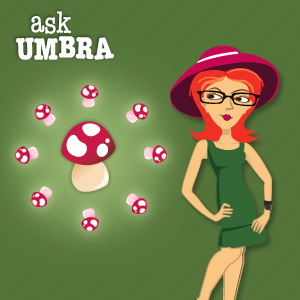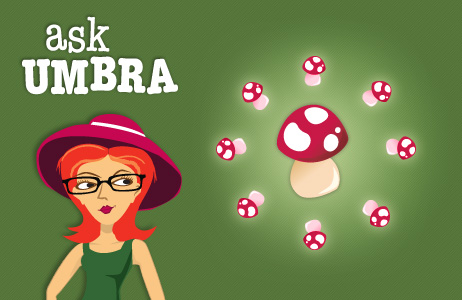Send your question to Umbra!
Q. Dear Umbra,
I’m a big fan of organic produce (especially when the local version isn’t at hand or I’m eating it raw), and I’m also one of those folks who is obsessed with mushrooms.
When I come across organic mushrooms, though, my curiosity is piqued: What don’t I know about the conventional mushroom market that warrants an organic alternative? Are these underground crops doused with pesticides, too?
I’d love for you to shed some light on my fungal-farming ignorance.
Mark
Tryon, N.C.
A. Dearest Mark,
 Did you hear the one about the mushroom that asked out this lady? She said, “No, I’m not going out with a mushroom!” So he said, “But I’m a fungi!” Get it? Fun … guy? Technically, though, he’s not a fungi. He’s a fungus. Singular form, you suave mushroom you.
Did you hear the one about the mushroom that asked out this lady? She said, “No, I’m not going out with a mushroom!” So he said, “But I’m a fungi!” Get it? Fun … guy? Technically, though, he’s not a fungi. He’s a fungus. Singular form, you suave mushroom you.
Anywho, my head is just spinning from an overwhelming dose of ‘shroom research and a fantastically informative phone call with the kind folks at the American Mushroom Institute. So here’s some dirt for you on mushroom production (we’ll leave wild foraging aside for now). First of all, mushrooms don’t grow underground. In fact, according to the AMI, most large-scale, commercial mushrooms are actually grown in climate-controlled buildings which keep out most pests. And chlorinated water is the most common disease control agent in the commercial mushroom industry. The substrate in which the mushrooms are grown is produced outside, where, also according to the AMI, minimal pesticides are used and biorational controls (read: naturally occurring pest pathogens and predators) are generally utilized to fend off the bad guys.
A mushroom is a very delicate little thing, and thus wouldn’t be doused with anything, including pesticides. Even when you’re cleaning them at your house post-grocer, you don’t want to douse. The Mushroom Council (not to be confused with the AMI — who knew there were so many dedicated mushroom groups?) says that because mushrooms are porous and have a sponge-like reaction to water, they should not be washed. Instead, you want to gently rub away any dirt with a soft brush or damp cloth.
Basically, the AMI peeps sum up the conventional versus organic mushroom conundrum with this: “There’s not a whole lot of difference between the two.”
As you may know, the Environmental Working Group has a handy list of fruits and vegetables ranked by pesticide residue levels. EWG puts mushrooms in the middle of the pack, at number 23 out of 45. So I wouldn’t sweat it too much. You’re better off focusing on organic versions of the top third of EWG’s list — items like peaches, apples, sweet bell peppers, and celery. And feel free to bust out this info at parties; I’m sure everyone will think you’re a really fun guy — or fungus, as the case may be.
Psychedelically,
Umbra
Q. Dear Umbra,
I recently adopted a dog and find myself in need of toys to keep his mouth occupied. In a world of plastic and rawhide chew toys, what are some good options for doggie toys that have the least impact on the environment?
Yours,
Jesse
New Orleans
A. Dearest Jesse,
Congrats on your new addition! Just to get this out of the way: To have the least impact on the environment, indeed the solution would be no pet at all. But I would never rob someone of the joy of four paws underfoot, and it’s commendable that you adopted a dog rather than investing in one of those dreaded puppy mills. So on with the inquiry.
Perhaps he’d enjoy keeping his mouth occupied with some organic mini muffins for pups (did you see my video with the teeny, tiny dog brigade?). When chewing rather than eating is the goal, I suggest you look for toys that are free of three nasties: PVC (no vinyl, that’s final!); plastic-softening, hormone-disrupting phthalates; and endocrine-disrupting BPA, which lends hardness and durability to plastics.
Pets are contaminated with even higher levels of toxic chemicals than humans are, according to a report from the EWG, and items like pet toys aren’t well-regulated. But HealthyStuff.org has a good list of newer pet toys along with test results for toxins in them. And although I don’t usually go the product endorsement route, I can recommend some other options to look into for your new pal: West Paw Design’s BPA-, PVC- and phthalate-free dog toys, which are recyclable through the company; sweet potato dog chews instead of animal rawhides; or a hemp rope bone. Maybe get creative and make your own dog toy from an old, unmatched sock. Or perhaps use something from nature, like a stick — don’t pull it from a living tree, though; wait for the tree to give it to you.
Finally, I’m no vet (gasp!), so be sure to check in with yours to make sure everything’s kosher with whatever toys you choose.
Also please pass this message on to your little fur ball, as I am, in fact, fluent in dog: Ruff, ruff, bark! Pant, pant, pant. He’ll know what it means.
Slobberly,
Umbra
Last week I tackled the topic of tots and table napkins. These readers jumped in with sage advice of their own.
Q. Dear Umbra,
I’d like to add on to your information on cloth napkins. In the dark ages of my childhood in the ’50s, my parents did not make decisions based on environmental issues. They hate to spend money, so disposable items were out (except for toilet paper). Each of us had our own napkin ring to identify our napkin that was used for many meals. Mine was silver with the name Virginia engraved on it. She was an aunt of my father who had passed away in the ’30s. Twenty-first century moms might look for individual napkin rings for their family.
Kathleen C.
Modesto, Calif.
Lindsay@TPA had this to say in the comments section of the column:
Napkins: For the kids and most any other regular use, check your local thrift shops. You can usually find sets of three or four for about $2. I’ve had some for as long as 10 years before I finally had to retire them to being cleaning rags. Of course, darker colors and prints show stains less, and if you take the advice about washing them in cold water and avoiding the dryer, your kids will be in high school before they wear out the napkins.
A. Dearest Kathleen and Lindsay@TPA,
Thanks for the great ideas. I’ve got a touch of DIY fever (and the only cure is more crafting), so I’m considering making my own napkin rings out of vintage 1990s paperclips I’ve found down here in the stacks. Readers, keep the goodness coming. It takes a village to save a planet, and I love to hear what you guys are up to.
Swan-shapedly,
Umbra



